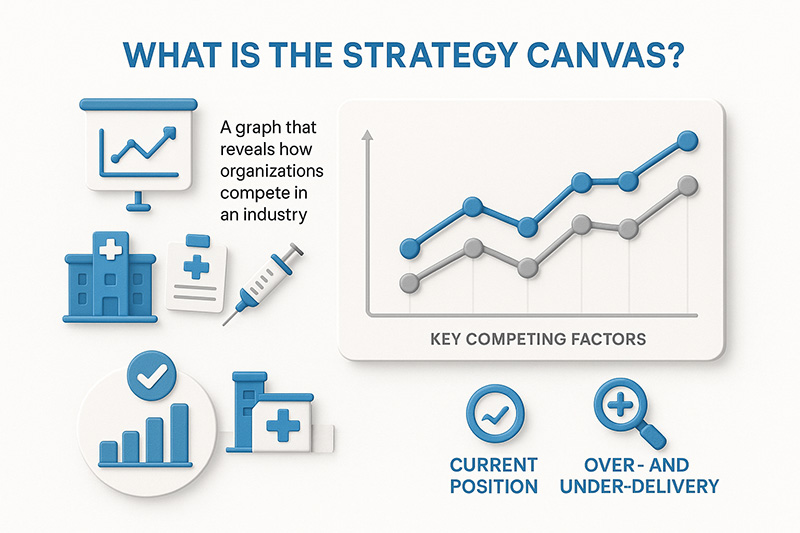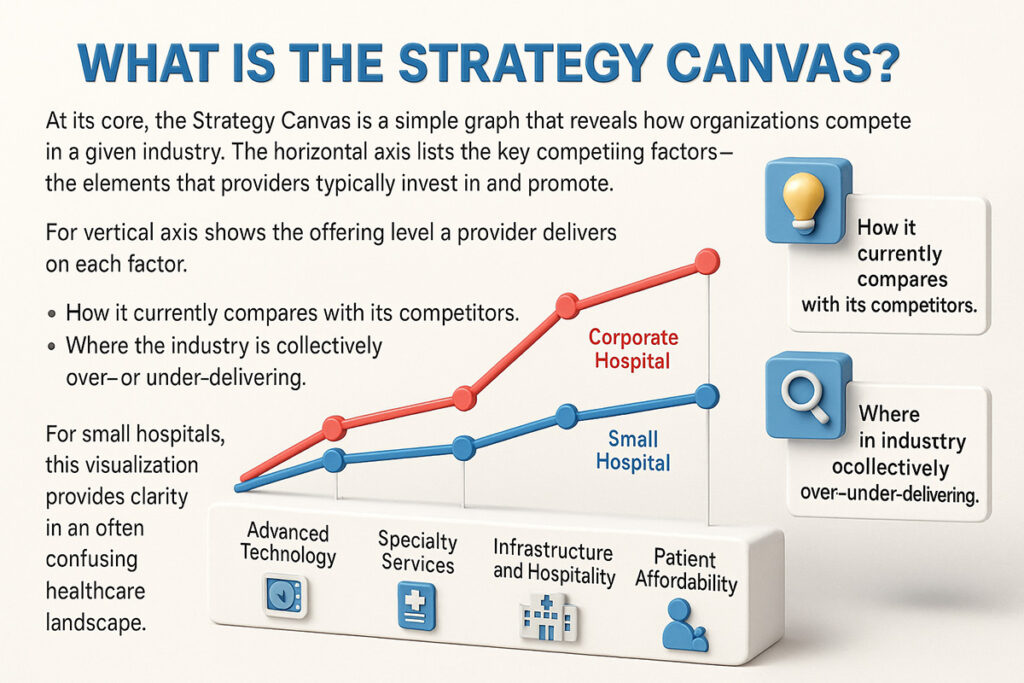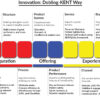
Healthcare these days is a competitive marketplace, more so in markets with big players from the private sector. Corporate hospitals continue to expand their presence relentlessly with high-end infrastructure, latest technologies, and brand name attracting patients and expertise in their direction. Small hospitals find it like battling a lost cause while competing head-to-head with behemoths like these.
Rather than fighting to survive in such a “red ocean” of head-to-head competition, smaller hospitals have to find a way to rethink their approach and discover untapped markets in the marketplace. The Strategy Canvas, diagnostic and actionable tool from W. Chan Kim and Renée Mauborgne’s book Blue Ocean Strategy, becomes very handy here. With it, smaller hospitals are able to present their competitive locations, challenge existing assumptions from the sector, and discover new ways of value creation where value is most significant.
What is the Strategy Canvas?
In short, the Strategy Canvas is a simple graph that reveals how organizations compete in an industry. The horizontal axis lists the key competing factors—those factors providers invest in and champion. The vertical axis shows the degree of offering a provider makes on each factor.
Through graphing these curves, an organization gains two excellent insights:
1. How it currently stacks up against competitors.
2. Where the sector over- or under-delivers collectively.
For smaller hospitals, this visualization creates transparency from the commonly confusing healthcare environment. They get to look at places they’re stuck with mimicry and places they must differ to distinguish value instead.
Typical Competing Factors in Healthcare
In health care organizations, the competing pressures most commonly moulding strategy are:
• Advanced clinical facilities and infrastructure.
• Wide range of specialty and super-specialty services.
• Infrastructure and hospitality, including luxury patient rooms.
• Number and quality of specialists.
• Speed and efficiency of service.
• Patient affordability and cost transparency.
• Accessibility and geographic convenience.
• Branding and marketing strength.
Most large hospitals vigorously compete on the first four—technology, scope of services, infrastructures, and brand recognition. Small hospitals, with scarce resources, play catch-up on these same items, with negative financial pressure but without commensurate volume.
The Red Ocean Trap
As the tiny hospitals mimic the corporate hospitals, they get caught in a downward spiral. For example, investing aggressively in expensive imaging technologies or super-specialty departments may create prestige, but unless there are enough patients to back those investments, costs outstrip the returns.
At the same time, things patients in the community likely value most—less time spent waiting, personal relationship with doctors, or affordability—fall through the cracks. The result is a disconnect between what hospitals have to offer and what patients value, with lost resources and idle facilities to follow.
The Strategy Canvas Creates Simplicity
Strategy Canvas helps small hospitals break out of the trap. By superimposing their value curve over their major competitors’, they instantly read the assumptions of the business and their own positioning.
For instance, a comparison of a typical small hospital with a big corporate hospital might reveal:
• Technology: Corporate Hospital does very well thanks to advanced machines, while the smaller hospital lags behind.
• Specialty coverage: Corporate hospital also covers with a number of departments; small hospital covers basic specialties just.
• Waiting times: Smaller hospital could actually do better, with quicker referrals compared to the big hospital’s bureaucratic processes.
• Affordability: Smaller hospital ranks higher due to lower fees and transparent billing.
• Doctor-patient relationship: Small hospital provides personalized care over the big-firm model of a big facility.
For vision, the curves would branch, with the corporate hospital having peaks in specialties and technology, and the smaller facility having peaks in accessibility, affordability, and personal care. This is a pointer to a strategic sector in which the smaller facility must invest all its energies—sectors which are resource-light but deeply valued by their patient community.

Practical Applications for Small Hospitals
- They assist
Strategy Canvas offers executives a framework to clarify and communicate what makes their hospital distinctive. A community hospital need not match a tertiary facility in cardiothoracic surgery but has the choice to emphasize quicker emergency response, affordable maternal care, or personal relationships with veteran area physicians.
2. Matching Strategy to Patient Needs
Instead of assuming patients want luxury interiors or high-tech but pricey diagnostics, smaller hospitals can take surveys, do focus groups, or host community meetings to ask what is valued most. These responses can then be integrated into the canvas as confirmation of focus areas.
3. Leading Investment
As there is an explicit picture of the industry’s value curve, there are no unsustainable investments in smaller hospitals. If something like “super-specialty expansion” is costly but irrelevant to the community, then the funds saved are spent on community health programs, digital consultation, or improved nursing care.
4. Staff and Stakeholder Alignments
As the canvas is a visual tool, it’s easy for administrators, doctors, and even external partners to comprehend the plan. This causes alignment within the company, so everyone does their part to uphold the same unique value proposition.
An illustrative example
It’s a 150-bed hospital in a semi-urban location. As an initial instinct, it aspires to rival a corporate chain opposite with new cardiology and oncology wings. But having developed a Strategy Canvas, the leaders realize their community needs something different—affordable diagnostics, quicker maternity services, and extension to rural places. By emphasizing these factors, the hospital distinguishes itself differently. Instead of fighting over the same pool of patients as the chain firm, it services an untapped population, wins loyalty, and balances growth. The diagram makes it clear to the management team that they are neither “missing out” on fighting over tech, but gaining traction through outperforming their competitors’ weakness.
Challenges and Cautions
Strategy Canvas is never a shortcut to success but a diagnostic starting point. One can misuse it if hospitals interpret it at a surface level or do not back it with patient-oriented data. There is also a risk of undertreating fundamental quality and safety norms, non-negotiables with hospitals. Regulatory compliance, clinical outcomes, and ethical practice must remain at the center of all strategies.
Final thoughts
Survival and growth for smaller hospitals are not about mimicking big players’ strategies but survival and growth are in embracing what their unique situation and their community’s needs are. Strategy Canvas provides an easy and effective framework to consider their business model’s differentiation, challenge existing assumptions, and guide strategic choices. By highlighting the things that truly matter to their patients and readjusting their value curve, small hospitals break out of the bloody red sea of competition and build their own blue oceans—regions of non-contestable possibility where they thrive.
Dr. Prahlada N.B
MBBS (JJMMC), MS (PGIMER, Chandigarh).
MBA in Healthcare & Hospital Management (BITS, Pilani),
Postgraduate Certificate in Technology Leadership and Innovation (MIT, USA)
Executive Programme in Strategic Management (IIM, Lucknow)
Senior Management Programme in Healthcare Management (IIM, Kozhikode)
Advanced Certificate in AI for Digital Health and Imaging Program (IISc, Bengaluru).
Senior Professor and former Head,
Department of ENT-Head & Neck Surgery, Skull Base Surgery, Cochlear Implant Surgery.
Basaveshwara Medical College & Hospital, Chitradurga, Karnataka, India.
My Vision: I don’t want to be a genius. I want to be a person with a bundle of experience.
My Mission: Help others achieve their life’s objectives in my presence or absence!My Values: Creating value for others.
Leave a reply
















Dear Dr. Prahlada N.B Sir,
I'd like to express my appreciation for your insightful post on Strategy Canvas and its potential to empower small hospitals. Your expertise in healthcare and hospital management shines through in your writing. The way you've explained the concept of Strategy Canvas and its application in the healthcare sector is truly commendable.
Your emphasis on smaller hospitals focusing on what truly matters to their patients, such as affordability, accessibility, and personalized care, resonates deeply. It's clear that your mission is to help others achieve their objectives, and your values of creating value for others are evident in your work.
Thank you for sharing your knowledge and experience with us.
Reply🌟 We are delighted to extend our full support and appreciation to Dr. Prahlada N.B. 🌟
On behalf of Dr Yash Patel, we are delighted to extend our wholehearted support for your upcoming article:
“Strategy Canvas: Empowering Small Hospitals to Visualize and Design Blue Ocean Strategies.” your work is a remarkable step towards helping healthcare institutions innovate and thrive.
Your vision of creating value for others and your mission of helping others achieve their life’s objectives resonates deeply with the values that Dr. Yash and our Swasthya ecosystem stand for — Empathy, Empowerment, and Evidence-based healthcare.
We truly appreciate the depth of expertise and leadership you bring — with your vast academic journey across JJMMC, PGIMER, BITS, MIT, IIMs, and IISc, coupled with your legacy as a senior professor and surgeon. Your article promises to be a powerful guide for small hospitals, enabling them to innovate, differentiate, and thrive in today’s competitive healthcare environment.
At Swasthya Diabetes Care, Swasthya Diabesity Care and Swasthya Retina Care, under the leadership of Dr Yash Patel and Dr. Kush Patel, we strongly resonate with your mission of creating value for others and empowering healthcare leaders to achieve sustainable impact.
We look forward to amplifying your thought leadership and ensuring this knowledge reaches doctors, administrators, and small hospitals who are ready to embrace Blue Ocean Strategies in healthcare.
Together, let’s shape a future where innovation and empathy go hand in hand. 💡💙
Warm regards,
ReplyTeam Swasthya | Office of Dr. Yash Patel
Swasthya Diabesity Care